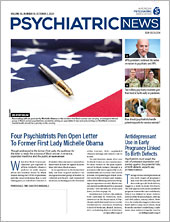Discrimination May Increase Risk of Severe Alcohol Use in Minorities
Racial and ethnic discrimination may increase the risk that members of minority groups will experience severe alcohol use disorder (AUD), according to a report in Drug and Alcohol Dependence.
“Our findings [should] prompt researchers and practitioners to consider the extent to which systems of oppression can impact the pathogenesis, trajectories, and recoveries (including relapse) of AUD,” wrote researchers from Kaiser Permanente Washington Health Research Institute and colleagues.
The authors analyzed data from 17,115 racial/ethnic minorities who participated in the National Epidemiological Survey on Alcohol-Related Conditions III (NESARC-III), a national survey that took place in 2012-2013. This included the responses of individuals who identified as American Indian or Alaskan Native; Asian, Native Hawaiian, or Other Pacific Islander; Black or African American; and Hispanic or Latino.
During in-person interviews, participants were evaluated using the AUD and Associated Disabilities Interview Schedule-5. (AUD severity levels were classified as mild, moderate, or severe: endorsing 2−3, 4–5, or ≥6 DSM-5 criteria, respectively.) The participants were also asked how often in the past year they felt they had “experienced discrimination, been prevented from doing something, or been hassled or made to feel inferior” because of their race or ethnicity.
In comparison with those who did not experience discrimination, those who experienced discrimination had a 1.5-fold greater risk of mild AUD, a 1.6-fold greater risk of moderate AUD, and a 2.3-fold greater risk of severe AUD.
“Strategies to reduce risk for severe AUD should include efforts to minimize the occurrence and impact of interpersonal and institutional racism,” they concluded.
COVID-19 Education, Proactive Coping Can Reduce Pandemic-Related Stress
A study in the Journal of Gerontology: Psychological Science found that adults who have more knowledge about COVID-19 may have less pandemic-related stress on average. The study also reported that older adults could help reduce pandemic stress by making proactive stress coping plans.
Investigators at North Carolina State University and the Georgia Institute of Technology surveyed 515 adults aged 20 to 79 from across the United States using Amazon’s Mechanical Turk online marketplace. The survey assessed the participants’ knowledge about the COVID-19 virus, their stress and anxiety about the pandemic, and any protective measures they were taking.
The survey results showed that regardless of age, participants who knew more about the virus had lower levels of COVID-related stress. Interestingly, overall stress levels did not differ by age groups, despite older adults being more likely to have adverse outcomes with infection.
The investigators found that adults over 50 had higher levels of COVID-related anxiety compared with younger adults, but also received more stress-reducing benefits from proactive coping strategies, such as setting goals or making plans for potential health events. Older adults also scored slightly higher on the knowledge quiz.
“Given the potential continuing and long-term impact of this pandemic, working toward support programs for older adults in terms of coping skills may be fruitful,” the investigators wrote.
Bumetanide May Improve Repetitive Behaviors, But Not Other ASD Symptoms
Some preliminary clinical studies have suggested the diuretic bumetanide can help reduce symptoms of autism spectrum disorder (ASD). These early studies used a general autism screening questionnaire as the outcome; they did not specifically assess core ASD symptoms, such as an atypical response to sensory inputs.
A randomized clinical study involving 92 children aged 7 to 15 with ASD now shows bumetanide is not superior to placebo in broad symptom improvement, but it may help some children with strong repetitive behaviors. The results were published in the Journal of the American Academy of Child and Adolescent Psychiatry.
Investigators at University Medical Centre Utrecht in the Netherlands and colleagues randomized participants to receive either twice-daily bumetanide or placebo for 91 days.
At the study’s end, they assessed for changes in the children’s social interactions, sensory responses, repetitive behaviors, and irritability. Bumetanide was not better than placebo for any of these core symptoms except for repetitive behaviors. Follow-up analysis suggested that girls taking bumetanide showed greater improvements in repetitive behaviors than boys taking the medication.
These results highlight how the heterogeneity of ASD can influence clinical trial research and the need to obtain functional data, such as brain scans, to understand how the treatments work, the authors wrote. “For now, we conclude that random off-label prescription of bumetanide for children with ASD is not recommended by our findings,” they concluded.
OUD Patients With Infections Often Stay at Hospital Longer
People with opioid use disorder (OUD) hospitalized for serious bacterial infections spend more time in the hospital and are more likely to be discharged to another facility rather than home, according to a study in PLoS Medicine. These discharge disparities occurred despite OUD patients being younger, having fewer comorbidities, and requiring less surgery on average than other patients with infections.
“These disparities in hospital stays and destinations after discharge suggest that people with opioid use disorder may lack post-discharge options such as skilled nursing facilities or home care for antibiotic infusions,” wrote the study authors. “Consideration should be given to expanding discharge options for people with opioid use disorder to reduce costly hospital stays and provide equitable care for serious infections.”
Investigators at Brigham and Women’s Hospital and colleagues used data from the 2016 National Inpatient Sample (which contains health information on approximately 8 million hospitalizations each year) to analyze discharge trends for serious bacterial infections such as internal abscesses. They identified 95,470 infection-related hospitalizations in their sample, of which 8% involved patients with OUD.
The average length of stay was 12.5 days for OUD patients compared with 8.1 days for patients without OUD. Due to this extra time, the average cost of treating infection in a patient with OUD was almost $24,000 more per stay, despite lower daily costs.
Patients with OUD were also less likely to be discharged home compared with patients without OUD (45.3% vs. 63.1%) and discharged with home health services (10.8% vs. 27.8%). They were more likely to have a patient-directed discharge against medical advice (19.1% vs. 2.6%) or to be transferred to another acute care hospital (6.8% vs. 4.5%). ■




